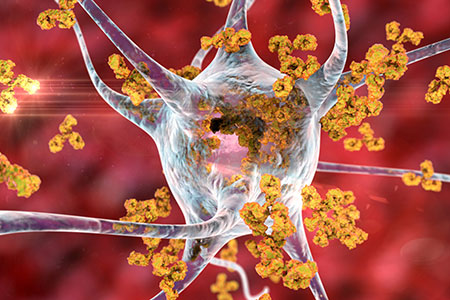 A hyperactive immune system can be a positive or a negative in the disease setting depending on the desired outcome. Autoimmune diseases such as graft-versus-host disease, lupus, inflammatory bowel disease, arthritis, IPEX, and more are caused by the immune system attacking healthy host tissue. These diseases can be modeled preclinically using humanized immune system (HIS) mice, with varying levels of success.
A hyperactive immune system can be a positive or a negative in the disease setting depending on the desired outcome. Autoimmune diseases such as graft-versus-host disease, lupus, inflammatory bowel disease, arthritis, IPEX, and more are caused by the immune system attacking healthy host tissue. These diseases can be modeled preclinically using humanized immune system (HIS) mice, with varying levels of success.
Studying Autoimmune Diseases in NOG Mice
Graft-versus-host disease
Graft-versus-host disease (GvHD) is frequently an unwanted side effect of engrafting human immune cells into a mouse. Depending on the source of immune cells used for engraftment (either hematopoietic stem cells (HSCs) or peripheral blood mononuclear cells (PBMCs)), the lifespan and study window of these mice differs. Due to the mismatch of the human immune cells and the murine host tissue, PBMC-engrafted immunodeficient mice, such as the huPBMC-NOG, have a study window of approximately 4-6 weeks before the animals succumb to GvHD. HIS mice engrafted instead with CD34+ human hematopoietic stem cells (HSCs) avoid the GvHD issue as the human immune cells mature in a mouse thymus — and therefore develop tolerance to mouse tissues, unlike PBMCs, which are fully mature at the time of engraftment.Sometimes, a GvHD response is desired. For example, NOG mice engrafted with PBMC can be used as a model to test the efficacy therapeutics that inhibit T cell activity by looking for amelioration of disease and measuring peripheral T cell and cytokine levels1. Another publication used a model of GvHD to evaluate various pathways that control T cell activation and whether they can be targeted therapeutically2.
Taconic Biosciences' NOG and hIL-2 NOG models can be used to intentionally generate a model of acute GvHD (aGvHD). Transplanting NOG mice with CD4+ T cells leads to rapid weight loss and infiltration of T cells into the lung, liver, and spleen. The CD4+ T cells in this model are crucial for their production of IL-2 that supports CD8+ T cells that drive pathogenesis. hIL-2 NOG transplanted with isolated hCD8+ T cells also develop aGvHD3.
Taconic's hIL-15 NOG can also be used to model GvHD. This model of GvHD supports not only T cells, but also NK and NKT cells, which drives the aggressive disease progression in this model and provides a study window of about one month. In a recent study by Incyte Research Institute, immune cell infiltration was observed throughout the body in the GI tract, eyes, lung, liver, and skin. Treatment with a JAK1/2 inhibitor (e.g., ruxolitinib) improved the health and survival of these animals, while disease was not responsive to steroids. Since around 50% of GvHD patients will eventually become steroid-refractory, models that show the efficacy of treatment on steroid-refractive GvHD are important to translational research4.
Inflammatory bowel disease (IBD)
Taconic's huNOG and huNOG-EXL (NOG mice additionally expressing hIL-3 and hGM-CSF and engrafted with CD34+ human HSCs) mice have been used to study DSS-induced IBD. In huNOG-EXL mice, 2.5% or 3% DSS administered for 10 days induced a slight decrease in body weight and a significant decrease in colon length compared to controls. However, this model does not respond to anti-TNF-alpha nor anti-IL-12p40 therapy as measured by no amelioration (and in fact, sometimes worsening) of body weight and colon length. Inhibitors of both the TNF-alpha and IL-23 signaling pathways have shown clinical efficacy in treating IBD; therefore, this model lacks predictive validity for the efficacy of these therapeutics. Taconic is currently evaluating other mechanisms of inducing IBD in HIS mice to improve the utility of this model.Arthritis
Arthritis has also been studied in human HSC-engrafted NOG mice. A 2011 publication by the CIEA described a model of erosive arthritis that resembles human rheumatoid arthritis (RA) in humanized NOG mice5. Following inoculation with Epstein-Barr virus (EBV), about 2/3 of the mice developed arthritis that recapitulated several features of human disease. In particular, synovial tissue proliferation within the joint accompanied by human CD4+ and CD8+ T cell infiltration into the joint and adjacent bone marrow. Neither inflammation nor joint pathology were observed in humanized NOG mice that were not infected with EBV. Importantly, the pathology in this model was not attributed to an antibody response or antigen mimicry; the observed T cell response parallels the pathology of RA in humans. EBV infection in humans can also trigger multiple sclerosis (MS) and systemic lupus erythematosus (SLE)6. These diseases have not yet been studied in humanized NOG mice, but the precedent set by the development of EBV-induced arthritis makes it an intriguing future direction.Autoimmune Diseases have been studied in other Strains of Humanized Immune System Mice
Other autoimmune diseases have been studied in humanized immune system mice other than the humanized NOG, such as the NSG and its derivatives. Some diseases such as Sjögren's syndrome have been modeled by engrafting patient-derived PBMC into severely immunocompromised mice7. A HIS model of MS/experimental autoimmune encephalomyelitis (EAE) uses the engraftment of human PBMC from healthy donors followed by immunization with myelin to trigger hCD4+ and hCD8+ T cell infiltration into the central nervous system8. In this discussion, however, we will focus on HSC-engrafted models of autoimmune disease.Systemic lupus erythematosus (SLE)
Characteristics of SLE that can be recapitulated in HIS mice include systemic inflammation including in the kidneys, B and T cell hyperactivation, and proinflammatory cytokine production. This pathology is triggered by intraperitoneal injection with pristane/TMPD, a mineral oil. This treatment can actually trigger SLE in many different mouse models, humanized and not. Using HIS mice allows for the study of the influence of human immune cells on lupus pathology and the impact of novel therapeutics. One characteristic of human SLE that is missing in existing HIS mouse models of lupus is the systemic upregulation of IFN-alpha9. This cytokine is produced by myeloid cells; thus using a HIS mouse that supports human myeloid cell engraftment such as Taconic's huNOG-EXL or hIL-6 NOG may provide additional insights into this disease.Chronic GvHD
Human IL-6-expressing severely immunocompromised mice have been used as a model to compare chronic versus acute GvHD. hIL-6 transgenic NSG mice transplanted with CD34+ HSCs to mimic chronic GvHD (cGVhD). The use of an IL-6-expressing model is translatable because clinical cGvHD has been associated with IL-6 polymorphisms and can be treated with an anti-IL-6 antagonist antibody. The pathology and cytokine profiling of this cGvHD model further mimics what is observed in clinical disease, including macrophage and T cell activation that may be driven directly by IL-610.IPEX
IPEX (immune dysregulation, polyendocrinopathy, enteropathy, X-linked syndrome) is a rare disorder of the immune system that is caused by a mutation in the FOXP3 gene that leads to Treg dysregulation. Taconic's huNOG-EXL mice support human Tregs. For the study of IPEX, patient-derived immune cells would be expected to engraft into these mice based upon the success of human leukemia engraftment into these mice as well as IPEX patient-derived bone marrow into immunodeficient mice on the NSG background11,12.Challenges and Future Directions
HIS mice have a great deal of potential for studying a variety of autoimmune diseases. Models from Taconic as well as other vendors have been used in this therapeutic area. Importantly, both the strain background and the engrafted human immune cells dictate the diseases that can be modeled. huNOG-EXL and hIL-6 NOG express human cytokines that support various immune cell types that may provide additional insight into a variety of autoimmune diseases.While the ability to study autoimmune diseases preclinically in the context of human immune cells can provide valuable insight into these diseases, it can lead to particular challenges as well. For models that require engraftment with patient-derived cells such as the aforementioned IPEX model, the availability of patient material may be limited and/or difficult to access. Preclinical models of autoimmunity also cause damage to the mouse tissue; therefore, some of these models can have short study windows of days (DSS-induced IBD) to weeks (aGvHD). Finally, like preclinical models of any human disease, models of autoimmunity recapitulate some, but not all symptoms of the disease that are observed clinically: for example, models of lupus in HIS mice that do not support myeloid cells do not recapitulate the overexpression of IFN-alpha even while demonstrating characteristic anti-nuclear antibodies and leukocyte-driven kidney damage (lupus nephritis).
Overall, HIS mice have shown promise for the study of autoimmune diseases but there is room for continued development of these models in the field to take full advantage of the human immune cell subsets that are supported by different mouse models.
















.jpg)

.jpg)
.jpg)
.jpg)
.jpg)





.jpg)


.jpg)
.jpg)




.jpg)




.jpg)

.jpg)





